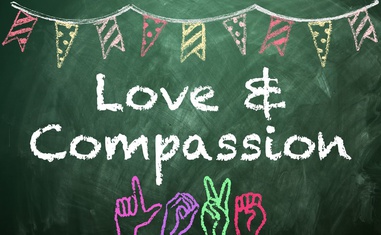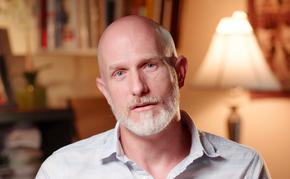In each human being, every noble spiritual value revolves around one all-important central virtue: love. Without it, we suffer tremendously – and with it, we flourish.
In a speech he gave in Maine in 1912, Abdu’l-Baha said it this way:
When we observe the phenomena of the universe, we realize that the axis around which life revolves is love …
While many different virtues enable us to be happy and successful as individuals, and help us empower our societies and our surroundings, love and compassion for others – or the lack of them – define and occupy most of our attention in life, whether directly or indirectly.
RELATED: Defining the 4 Different Types of Love
We are all primarily motivated by love, either the love others express for us as we grow, or the love we feel in our hearts toward others. The comprehension of love is one of the most important aspects of our self-growth. In order to reach maturity and have a clear state of mind, we need to understand both our physical and mental states in relation to love.
First, let’s look at how our brains analyze and react to love. Richard Schwartz and Jacqueline Olds, Harvard Medical School professors and authors of many couples therapy studies, explain the relationship between our brain and love:
When we are falling in love, chemicals associated with the reward circuit flood our brain, producing a variety of physical and emotional responses — racing hearts, sweaty palms, flushed cheeks, feelings of passion and anxiety. Levels of the stress hormone cortisol increase during the initial phase of romantic love, marshaling our bodies to cope with the “crisis” at hand. As cortisol levels rise, levels of the neurotransmitter serotonin become depleted. Low levels of serotonin precipitate what Schwartz described as the “intrusive, maddeningly preoccupying thoughts, hopes, terrors of early love” — the obsessive-compulsive behaviors associated with infatuation.
We now know, scientifically, that dopamine activates the reward circuit in our brain, oxytocin is responsible for creating feelings of contentment and security, and vasopressin provokes the faithful, devoted behavior that produces long-term monogamous relationships.
Schwartz and Olds elucidate that the positive and negative feelings in our brain are channeled through two separate neurological pathways. Love creates the positive feelings in us, but it also “deactivates the neural pathway responsible for negative emotions, such as fear and social judgment.” The pathway associated with positive emotions “connects the prefrontal cortex to the nucleus accumbens,” and the one related to negative emotions, “connects the nucleus accumbens to the amygdala.” They add:
When we are engaged in romantic love, the neural machinery responsible for making critical assessments of other people, including assessments of those with whom we are romantically involved, shuts down.
Schwartz explains that in lasting love the rollercoaster of emotions calms over time. The chemicals related to passion still remain at high levels in the brain, but “the stress of it is gone.” “Cortisol and serotonin levels return to normal. Love, which began as a stressor (to our brains and bodies, at least), becomes a buffer against stress.” This results in the transition of a passionate love to what we call a compassionate love.
Likewise, in her article, The Upstairs and Downstairs of the Brain, Ann Young delineates the brain using three simple terms: “the downstairs brain, the upstairs brain, the staircase.”
She says the “downstairs brain,” often referred to as the reptilian or primitive brain, contains the brain stem, limbic region, and the amygdala. This instinctive part of the brain is well-developed from birth, and is responsible for:
- Basic bodily functions – breathing, blinking, heartbeat, flinching, digestion, etc.
- Innate responses – fight, flight, freeze.
- Producing strong emotions such as anger and fear.
Young adds:
The upstairs brain is significantly more sophisticated than the downstairs brain and is made up of the cerebral cortex and its various parts, in particular the middle prefrontal cortex located behind the forehead. This part of the brain is responsible for higher order thinking and planning, imagining, analyzing, problem solving and sound decision making. The upstairs provides a fuller perspective of the world and enables us to emotionally regulate and to have control over our body. When this part of the brain is working well, we are able to utilize self-understanding, empathy and morality, as well as considering consequences and thinking before we act.
In children, she writes, “this part of the brain is not capable of functioning all of the time and thus children cannot always access their ability to make sound decisions, control their behavior or show empathy.” Moreover:
The two levels of our brain are linked by a metaphorical staircase that allows the flow of information up and down the stairs from the upper and lower brain. This enables the upstairs to monitor the actions of the downstairs and calm strong emotions, reactions and impulses. When working well, the staircase enables us to consider the emotional and physical messages coming from the downstairs brain and use the thinking and analyzing upstairs brain to determine a course of action.
As parents, our goal is to help build and reinforce this metaphorical staircase allowing for vertical integration between the upper and lower parts of the brain. This integration in turn helps to strengthen the staircase by encouraging the free flow of messages to travel up and down the stairs. In times of high emotion and stress, when the amygdala becomes involved, children can find themselves being ‘trapped downstairs’ unable to access the logic and consideration of the upstairs brain.
True love and compassion emerge from positive cognitive and emotional growth. The study of human virtues helps develop the upstairs brain and strengthens the staircase. Also, understanding how our brain functions helps us control our emotions and make the right decision when it comes to our choices.
These regions of our brains correspond, in a Baha’i context, to the animal nature and the spiritual nature. As Abdu’l-Baha said in this 1912 address to the Theosophical Society in New York City, the Divine prophets and messengers appear in order to teach humanity to aspire to our higher natures – essentially, to love one another:
The holy Manifestations of God come into the world to dispel the darkness of the animal, or physical, nature of man, to purify him from his imperfections in order that his heavenly and spiritual nature may become quickened, his divine qualities awakened, his perfections visible, his potential powers revealed and all the virtues of the world of humanity latent within him may come to life.
In short, science and spirituality are two wings that can assist our growth mentally and spiritually. After studying the chemical and physical aspects of love and how our brain functions, we can better comprehend Abdu’l-Baha’s explanation about love:
Know thou of a certainty that Love is the secret of God’s holy Dispensation, the manifestation of the All-Merciful, the fountain of spiritual outpourings. Love is heaven’s kindly light, the Holy Spirit’s eternal breath that vivifieth the human soul. Love is the cause of God’s revelation unto man, the vital bond inherent, in accordance with the divine creation, in the realities of things. Love is the one means that ensureth true felicity both in this world and the next. Love is the light that guideth in darkness, the living link that uniteth God with man, that assureth the progress of every illumined soul.
Love is the greatest law that ruleth this mighty and heavenly cycle, the unique power that bindeth together the diverse elements of this material world, the supreme magnetic force that directeth the movements of the spheres in the celestial realms. Love revealeth with unfailing and limitless power the mysteries latent in the universe. Love is the spirit of life unto the adorned body of mankind, the establisher of true civilization in this mortal world, and the shedder of imperishable glory upon every high-aiming race and nation.
Love, as the “axis around which life revolves,” can help us become truly noble individuals and help promote peace and unity in the world around us.
Setareh Samandari Zargarpour has always been an artist at heart, after a 20-year career in Banking as Branch Manager for Wells Fargo and Chase she transitioned to working in Film. She had finished her Master of Arts in Political Science from CSUN and utilized it...
READ MORE

















Comments
Sign in or create an account
Continue with Facebookor